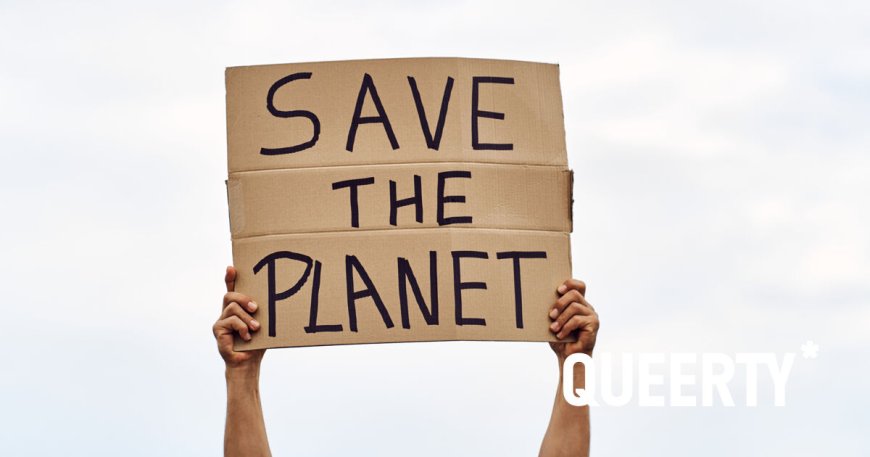Gay people are at greater risk to the negative impacts of climate change for this specific reason…
Gay people cluster in communities that could be devastated by climate change.


We know there are a rash of inequities between LGBTQ+ people and straight people. And unfortunately, we can add another one to the list: exposure to the negative impacts of climate change.
UCLA’s Williams Institute published a new study showing the vulnerability of same-sex couples to climate change in comparison to hetero couples. Researchers found when there is a 1% increase in proportion of same-sex couples in a county, it coincides with a 17.7% increase in the NASA composite risk score. The metric reflects a region’s severity of risk in regards to meteorological factors such as heat waves, extreme cold, excessive precipitation and drought.
Similarly, a 1% increase in proportion of same-sex couples in a county is associated with a 6.13% increase in the FEMA Projection Score, which focuses on natural disasters such as hurricanes, floods and tornadoes.
How about we take this to the next level?
Subscribe to our newsletter for a refreshing cocktail (or mocktail) of LGBTQ+ entertainment and pop culture, served up with a side of eye-candy.
Subscribe to our Newsletter today
How homophobic… right?!
In all seriousness, the reason for the stark disparity is the fact that LGBTQ+ folx flock to coastal and urban areas, which face greater risk than landlocked and suburban counties. Among the 15 counties with the highest proportion of same-sex couples, all are coastal or urban.
That isn’t surprising, of course. New York has the largest number of LGBTQ+ adults out of any metro area, followed by Los Angeles and Chicago. Miami and Dallas are four and five on the list, respectively.
Meanwhile, the highest percentage of LGBTQ+ adults can be found in the San Francisco metro area.
While all of those cities are gay metropolises where queer people are more safe and accepted, they’re also susceptible to extreme heat and weather events. The most dire projections indicate parts of Manhattan could be underwater by… 2050! Yikes!
Gays tend to live in cities near the coast, study finds https://t.co/rB4UCfGWBM pic.twitter.com/WeOrl4cB7y— Josh Barro (@jbarro) May 23, 2024
The San Francisco gay community was famously built up with blue tickets.— Crémieux (@cremieuxrecueil) May 24, 2024
oh ok i get the key west thing now, it's objectively the most coastal part of the country— Matthew Zeitlin (@MattZeitlin) May 23, 2024
In a slight break from the trend, the state or territory with the highest percentage of LGBTQ+ residents is the District of Columbia, with 14.5% of the adult population. But D.C. is facing challenges as well. The latest National Climate Assessment found the region is especially at risk of extreme weather, flooding, and sea level rise.
“Washington, D.C., a county equivalent, has the highest proportion of same-sex couples of any county in the United States,” says the report from the Williams Institute. “It scores high for a variety of climate risks, including heat waves (97th percentile), flooding (95th percentile), and dangerously strong winds (98th percentile).”
Gay beach oases, such as Provincetown and Fire Island, also face extreme risk from climate change. Located on the tip of Cape Cod, Ptown is facing an existential crisis. The town’s Herring Cove Beach, and its dunes, are an indelible part of gay artistry lore.
It’s also facing rapid erosion.
The story isn’t better on Fire Island, where communities are calling for emergency relief. Just a few years back, the federal government spent $1.7 billion to quell erosion on the South Long Island shore. Now, parts of the beach at Fire Island Pines are “as wide as a volleyball net,” the New York Times reports.
To combat the impending disaster, the Williams Institute offers an array of recommendations. Among them:
- Ensuring “disaster relief is accessible and administered without discrimination on the basis of orientation, gender identity, or gender expression
- Prioritizing green space in urban areas and “enhancing structural resilience”
- Enact policies that mitigate discriminatory housing practices and provide economic relief to LGBTQ+ people
We know that LGBTQ+ folx will figure out how to mitigate their climate risk in the upcoming decades, because we always find a way. But there’s no hiding from the truth: there’s a lot of work to be done.

 Mark
Mark 





